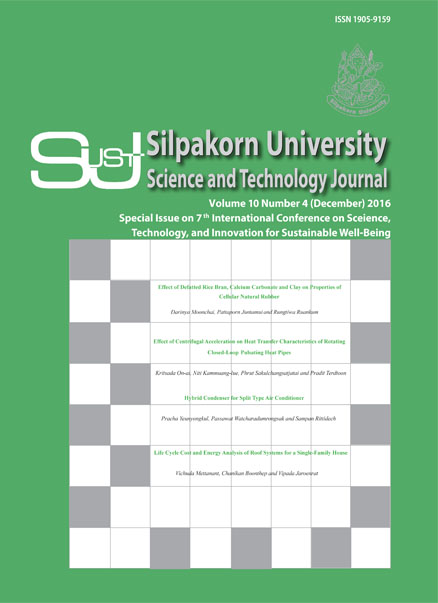Hybrid Condenser for Split Type Air Conditioner
Main Article Content
Abstract
The aim of this research is to experimentally investigate the application of a hybrid condenser as the condenser for a vapor compression refrigeration system. Split type air conditioner for residential use has two major disadvantages. First, it has a large pressure drop in the condenser caused by the flow of refrigerant inside a small tube which affects compressor power. Second, a large amount of heat is rejected to the surroundings since the refrigerant has to condense after passing through the condenser. To decrease pressure drop and recover heat rejection from the condensing process, this study considered using hybrid condenser instead of the conventional condenser in the split type air conditioner. The refrigeration capacity was set at 12,500 Btu/h (3.663 kW) with R22 as the refrigerant.
The optimum size of the thermosyphon with water as the working fluid consists of 0.1 meter of evaporator section length, 0.1 meter of condenser section length, the thermosyphon with an inner diameter of 6.5 millimeter, and 105 tubes. Therefore, these sizes were selected to construct the hybrid condenser. The experimental results were obtained and compared with the conventional condenser. It was found that temperature difference between ambient and room of the conventional condenser system was 11.5 ºC. While thetemperature difference of the hybrid condenser system with water flow rate of 4, 6 and 8 LPM were 15.9, 16.6 and 17.3 ºC, respectively. In addition, electric power consumptionof the conventional condenser system was 1,423 W. While theelectric power consumption of the hybrid condenser system with water flow rate of 4, 6 and 8 LPM were 1,315, 1,309 and 1,295 W, respectively. When both systems were compared with the same heat load, it was found that the electric power consumptionof the hybrid condenser system of 4, 6 and 8 LPM were decreased by about 8.2, 8.7 and 9.9%,respectively. Finally, the outlet temperature of the cooling water which recovers heat from the condenser section of the hybrid condenser with the water flow rate of 4, 6 and 8 LPM were 6.6, 8.2 and 9.8ºC, respectively.
Downloads
Article Details
References
Meena, P., Rittidech, S., and Poomsa-Ad, N.(2007). Closed-loop oscillating heat-pipe with check valves (CLHPCVs) air-preheater for reducing relative humidity in drying systems. Applied Energy, 84: 363-373.
Shiming, D., and Han, H. (2004). An experimental study on clothes drying using rejected heat (CDURH) with split-type residential air conditioners. Applied Thermal Engineering, 24: 2789-2800.
Söylemez, M.S. (2003). On the thermoeconomical optimization of heat pipe heat exchanger HPHE for waste heat recovery. Energy Conversion and Management, 44: 2509-2517.
Yeunyongkul, P., Sakulchangsajatai, P., and Ghajar, A. J. (2010). Experimental investigation of closed loop oscillating heat pipe as the condenser for vapor compression refrigeration. In 13th International Refrigeration and Air conditioning Conference, Indiana, USA.


